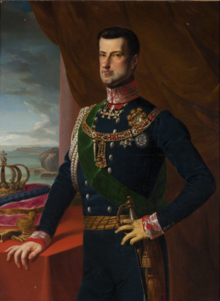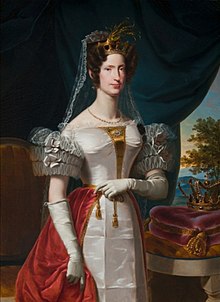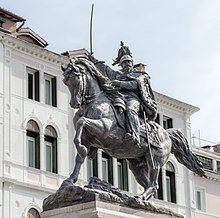Victor Emmanuel II
This article includes a list of general references, but it lacks sufficient corresponding inline citations. (May 2022) |
| Victor Emmanuel II | |||||
|---|---|---|---|---|---|
 Victor Emmanuel, c. 1861 | |||||
| King of Italy | |||||
| Reign | 17 March 1861 – 9 January 1878 | ||||
| Predecessor | Napoleon (1814) | ||||
| Successor | Umberto I | ||||
| Prime ministers | See list | ||||
Prime ministers | See list
| ||||
| Born | 14 March 1820 Palazzo Carignano, Turin, Kingdom of Sardinia | ||||
| Died | 9 January 1878 (aged 57) Quirinal Palace, Rome, Kingdom of Italy | ||||
| Burial | |||||
| Spouse | |||||
| Issue see details... | |||||
| |||||
Roman Catholicism | |||||
| Signature | |||||
Victor Emmanuel II (
Born in
Victor Emmanuel supported the Expedition of the Thousand (1860–1861) led by Giuseppe Garibaldi, which resulted in the rapid fall of the Kingdom of the Two Sicilies in southern Italy. However, Victor Emmanuel halted Garibaldi when he appeared ready to attack Rome, still under the Papal States, as it was under French protection. In 1860, Tuscany, Modena, Parma and Romagna decided to side with Sardinia, and Victor Emmanuel then marched victoriously in the Marche and Umbria after the victorious Battle of Castelfidardo over the Papal forces. This led to his excommunication from the Catholic Church until 1878, just before his death in the same year. He subsequently met Garibaldi at Teano, receiving from him the control of southern Italy and becoming the first King of Italy on 17 March 1861.
In 1866, the Third Italian War of Independence allowed Italy to annex Veneto. In 1870, Victor Emmanuel also took advantage of the Prussian victory over France in the Franco-Prussian War to conquer the Papal States after the French withdrew. He entered Rome on 20 September 1870 and set up the new capital there on 2 July 1871. He died in Rome in 1878, and was buried in the Pantheon.
The Italian national
Biography




Victor Emmanuel was born as the eldest son of
He took part in the
He became
In 1852, he appointed

Crimean War

Following Victor Emmanuel's advice, Cavour joined Britain and France in the Crimean War against Russia. Cavour was reluctant to go to war due to the power of Russia at the time and the expense of doing so. Victor Emmanuel, however, was convinced of the rewards to be gained from the alliance created with Britain and, more importantly, France.
After successfully seeking British support and ingratiating himself with France and Napoleon III at the
Wars of Italian Unification
The Italo-French campaign against Austria in 1859 started successfully. However, sickened by the casualties of the war and worried about the mobilisation of Prussian troops, Napoleon III secretly made a treaty with
Later that same year, Victor Emmanuel II sent his forces to fight the papal army at Castelfidardo and drove the Pope into
Victor Emmanuel supported Giuseppe Garibaldi's Expedition of the Thousand (1860–1861), which resulted in the rapid fall of the Kingdom of the Two Sicilies in southern Italy. However, the king halted Garibaldi when he appeared ready to attack Rome, still under the Papal States, as it was under French protection. In 1860, through local plebiscites, Tuscany, Modena, Parma and Romagna decided to side with Piedmont-Sardinia. Victor Emmanuel then marched victoriously in the Marche and Umbria after the victorious battle of Castelfidardo (1860) over the Papal forces.
The king subsequently met with Garibaldi at Teano, receiving from him the control of southern Italy. Another series of plebiscites in the occupied lands resulted in the proclamation of Victor Emmanuel as the first King of Italy by the new Parliament of unified Italy, on 17 March 1861. He did not renumber himself after assuming the new royal title, however. Turin became the capital of the new state. Only Lazio, Veneto, and Trentino remained to be conquered.

Completion of the unification


In 1866 Victor Emmanuel allied himself with Prussia in the Third Italian War of Independence. Although not victorious in the Italian theatre, he managed to receive Veneto after the Austrian defeat in Germany. The British Foreign Secretary, Lord Clarendon, visited Florence in December 1867 and reported to London after talking to various Italian politicians: "There is universal agreement that Victor Emmanuel is an imbecile; he is a dishonest man who tells lies to everyone; at this rate, he will end up losing his crown and ruining both Italy and his dynasty."[3] In 1870, after two failed attempts by Garibaldi, he also took advantage of the Prussian victory over France in the Franco-Prussian War to capture Rome after the French withdrew. He entered Rome on 20 September 1870 and set up the new capital there on 2 July 1871, after a temporary move to Florence in 1864. The new Royal residence was the Quirinal Palace.
The rest of Victor Emmanuel II's reign was much quieter. After the Kingdom of Italy was established he decided to continue on as King Victor Emmanuel II instead of Victor Emmanuel I of Italy. This was a terrible move as far as public relations went as it was not indicative of the fresh start that the Italian people wanted and suggested that Piedmont-Sardinia had taken over the Italian Peninsula, rather than unifying it. Despite this mishap, the remainder of Victor Emmanuel II's reign was consumed by wrapping up loose ends and dealing with economic and cultural issues. His role in day-to-day governing gradually dwindled, as it became increasingly apparent that a king could no longer keep a government in office against the will of Parliament. As a result, while the wording of the Statuto Albertino stipulating that ministers were solely responsible to the crown remained unchanged, in practice they were now responsible to Parliament.
Victor Emmanuel died in Rome in 1878, after meeting with the envoys of
Family and children
In 1842 he married his paternal first cousin (aunt's daughter) Adelaide of Austria (1822–1855). With her, he had eight children:[5]
- Prince Louis Napoléonwas the Bonapartist pretender to the French imperial throne.

- Umberto (1844–1900), later King of Italy. He married his first cousin Margherita of Savoy.
- Maria Letizia Bonaparte.
- Oddone Eugenio Maria (1846–1866), Duke of Montferrat.
- Louis of Portugal.
- Carlo Alberto (2 June 1851 – 28 June 1854), Duke of Chablais.
- Vittorio Emanuele (6 July 1852 – 6 July 1852).
- Vittorio Emanuele (18 January 1855 – 17 May 1855), Count of Geneva.
In 1869 he married
- Vittoria Guerrieri (2 December 1848 – 29 December 1905), married three times: to Giacomo Spinola, Luigi Spinola and Paolo DeSimone. She had issue.
- Emanuele Alberto Guerrieri (16 March 1851 – 24 December 1894), Count of Mirafiori and Fontanafredda, married and had issue.

In addition to his morganatic second wife, Victor Emmanuel II had several other mistresses:
1) Laura Bon at Stupinigi, who bore him two children:
- Stillborn child (1852-1852).
- Emanuela of Roverbella (6 September 1853 – 1896).
2) Baroness Vittoria Duplesis who bore him another daughter:
- Maria Savoiarda Projetti (1854–1885/1888).
3) Unknown mistress at Mondovì, mother of:
- Donato Etna (1858–1938) who became a soldier during the First World War.
4) Virginia Rho at Turin, mother of two children:
- Vittorio di Rho (1861 – Turin, 10 October 1913). He became a notable photographer.
- Maria Pia di Rho (25 February 1866 – Vienna, 19 April 1947). Married to count Alessandro Montecuccoli.
5) Rosalinda Incoronata De Domenicis (1846–1916), mother of one daughter:
- Vittoria De Domenicis (1869–1935) who married doctor Alberto Benedetti (1870–1920), with issue.
6) Angela Rosa De Filippo, mother of:
- Actor Domenico Scarpetta (1876–1952)
Honours and arms
| Styles of King Victor Emmanuel II | ||
|---|---|---|
Reference style His Majesty | | |
| Spoken style | Your Majesty | |
Italian
- Knight of the Order of the Annunciation, 23 December 1836;[6] Grand Master, 23 March 1849
- Grand Cross of the Order of Saints Maurice and Lazarus, 1836; Grand Master, 23 March 1849
- Grand Master of the Military Order of Savoy
- Grand Master of the Order of the Crown of Italy
- Grand Master of the Civil Order of Savoy
- Gold Medal of Military Valour
- Silver Medal of Military Valour
- Medal of the Liberation of Rome (1849–1870)
- Commemorative Medal of Campaigns of Independence Wars
- Commemorative Medal of the Unity of Italy
 Tuscan Grand Ducal family: Grand Cross of the Order of St. Joseph[7]
Tuscan Grand Ducal family: Grand Cross of the Order of St. Joseph[7]
Foreign
 Austrian Empire:
Austrian Empire:
- Knight of the Order of the Golden Fleece, 1841[8]
- Grand Cross of the Order of St. Stephen, 1869[9]
 Baden:[10]
Baden:[10]
- Knight of the House Order of Fidelity, 1864
- Grand Cross of the Order of the Zähringer Lion, 1864
 Order of St. Hubert, 1869[11]
Order of St. Hubert, 1869[11] Belgium: Grand Cordon of the Order of Leopold, 25 July 1855[12]
Belgium: Grand Cordon of the Order of Leopold, 25 July 1855[12] Denmark: Knight of the Order of the Elephant, 2 September 1861[13]
Denmark: Knight of the Order of the Elephant, 2 September 1861[13] French Empire:
French Empire:
 Kingdom of Hawaii: Grand Cross of the Order of Kamehameha I, 1865[14]
Kingdom of Hawaii: Grand Cross of the Order of Kamehameha I, 1865[14] Mexican Empire: Grand Cross of the Order of the Mexican Eagle, with Collar, 1865[15]
Mexican Empire: Grand Cross of the Order of the Mexican Eagle, with Collar, 1865[15] Kingdom of Prussia:[16]
Kingdom of Prussia:[16]
- Knight of the Order of the Black Eagle, 12 January 1866; with Collar, 1875
- Pour le Mérite (military), 29 May 1872
 Kingdom of Saxony: Knight of the Order of the Rue Crown, 1850[17]
Kingdom of Saxony: Knight of the Order of the Rue Crown, 1850[17]- Order of the Seraphim, 30 August 1861[18]
 Beylik of Tunis: Husainid Family Order[19]
Beylik of Tunis: Husainid Family Order[19] United Kingdom: Stranger Knight of the Order of the Garter, 5 December 1855[20]
United Kingdom: Stranger Knight of the Order of the Garter, 5 December 1855[20]
Arms
 |
 |
 |
|---|---|---|
| Arms as knight of the Golden Fleece | Coat of arms as King of Sardinia (1849–1861) | Greater coat of arms as King of Italy (1861–1878) |
Ancestry
| Ancestors of Victor Emmanuel II | ||||||||||||||||||||||||||||||||||||||||||||||||||||||||||||||||||||||||||||||||||||||||
|---|---|---|---|---|---|---|---|---|---|---|---|---|---|---|---|---|---|---|---|---|---|---|---|---|---|---|---|---|---|---|---|---|---|---|---|---|---|---|---|---|---|---|---|---|---|---|---|---|---|---|---|---|---|---|---|---|---|---|---|---|---|---|---|---|---|---|---|---|---|---|---|---|---|---|---|---|---|---|---|---|---|---|---|---|---|---|---|---|
| ||||||||||||||||||||||||||||||||||||||||||||||||||||||||||||||||||||||||||||||||||||||||
See also
- Unification of Italy
- Camillo Benso, Count of Cavour
- Giuseppe Garibaldi
- Victor Emmanuel II Monument
- Rome
- Kingdom of Italy
- Italian Islands of the Aegean
- Italian Libya
- Italian East Africa
- Italian Ethiopia
- Emperor of Ethiopia
- Pietro Badoglio
Notes
- ^ a b Victor Emmanuel and his successors retained the title "King of Sardinia" after the Kingdom of Sardinia became the Kingdom of Italy in 1861.
References
- ISBN 9780810866133.
- ^ a b Chisholm 1911.
- ^ Mack Smith, Denis Italy and its Monarchy, New Haven: Yale University Press, 1989 p. 42
- ^ "Excommunicating Politicians". 27 September 2004.
- ^ Genealogical data from the Savoia[permanent dead link] page of the Genealogie delle famiglie nobili italiane website.
- ^ Luigi Cibrario (1869). Notizia storica del nobilissimo ordine supremo della santissima Annunziata. Sunto degli statuti, catalogo dei cavalieri. Eredi Botta. p. 107.
- ^ Almanacco Toscano per l'anno 1855. Stamperia Granducale. 1840. p. 275.
- ^ Boettger, T. F. "Chevaliers de la Toisón d'Or - Knights of the Golden Fleece". La Confrérie Amicale. Retrieved 25 June 2019.
- ^ "A Szent István Rend tagjai" Archived 22 December 2010 at the Wayback Machine
- ^ Hof- und Staats-Handbuch des Großherzogtum Baden (1865), "Großherzogliche Orden" pp. 55, 66
- ^ Hof- und Staats-Handbuch des Königreich Bayern (1873), "Königliche Orden" p. 8
- ^ Ferdinand Veldekens (1858). Le livre d'or de l'ordre de Léopold et de la croix de fer. lelong. p. 214.
- ISBN 978-87-7674-434-2.
- ^ "The Royal Order of Kamehameha". crownofhawaii.com. Official website of the Royal Family of Hawaii. Archived from the original on 28 February 2023. Retrieved 2 December 2019.
- ^ "Seccion IV: Ordenes del Imperio", Almanaque imperial para el año 1866 (in Spanish), 1866, p. 242, retrieved 29 April 2020
- ^ "Königlich Preussische Ordensliste", Preussische Ordens-Liste (in German), 1, Berlin: 12, 24, 1877
- ^ Sachsen (1866). Staatshandbuch für den Freistaat Sachsen: 1865/66. Heinrich. p. 4.
- ^ Sveriges statskalender (in Swedish), 1877, p. 368, retrieved 2 May 2020 – via runeberg.org
- ^ "Nichan ad-Dam, ou ordre du Sang, institué... - Lot 198".
- ^ Shaw, Wm. A. (1906) The Knights of England, I, London, p. 59
Sources
- Chisholm, Hugh, ed. (1911). . Encyclopædia Britannica. Vol. 28 (11th ed.). Cambridge University Press.
- Mack Smith, Denis, 1920-2017. (1972). [Victor Emanuel, Cavour and the Risorgimento.] Vittorio Emanuele II. (Traduzione ... di Jole Bertolazzi.). Laterza. )
- Thayer, William Roscoe (1911). The Life and Times of Cavour vol 1. old interpretations but useful on details; vol 1 goes to 1859]; volume 2 online covers 1859–62
In Italian
- Del Boca, Lorenzo (1998). Maledetti Savoia. Casale Monferrato: Piemme.
- Gasparetto, Pier Francesco (1984). Vittorio Emanuele II. Milan: Rusconi.
- Mack Smith, Denis (1995). Vittorio Emanuele II. Milan: Mondadori.
- Pinto, Paolo (1997). Vittorio Emanuele II: il re avventuriero. Milan: Mondadori.
- Rocca, Gianni (1993). Avanti, Savoia!: miti e disfatte che fecero l'Italia, 1848–1866. Milan: Mondadori.

